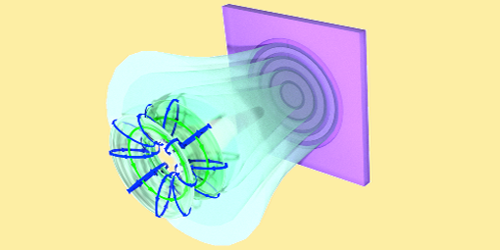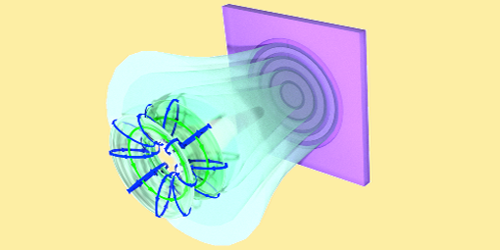Metamaterials Could Produce Flying Doughnuts
Textbook electromagnetic waves are typically transverse, which means their electric and magnetic fields point perpendicularly to the direction of wave propagation. However, certain electromagnetic waveforms have longitudinal field components that are parallel to the propagation direction. One example is the flying electromagnetic doughnut, whose fields wrap around in a torus pattern. Such pulses could potentially transfer information, accelerate particles, or perform spectroscopy, but so far they have never been observed. A new scheme by Nikolay Zheludev from the University of Southampton, UK, and colleagues shows how flying doughnuts might be generated using a metamaterial based on a circular array of resonators.
Proposed over 20 years ago, flying doughnuts are one-cycle pulses, meaning the fields go up and down just once as the wave packet passes through a point in space. Such a compact pulse would be ideal for delivering energy or information. The problem is that the complicated spatiotemporal structure of a flying doughnut cannot be generated by a single antenna but requires an array of antennae emitting waves at different frequencies and with different phases. Coordinating electrical inputs to the antennae to produce such an emission pattern at optical wavelengths is beyond current technology.
The strategy of Zheludev and colleagues allows conversion of an ordinary light pulse into a flying doughnut by using a polarization converter and a specially designed metamaterial. The proposed metamaterial is a flat sheet containing a pattern of small dipole resonators arranged in concentric rings. When excited by the incoming light pulse, the resonators individually emit pulses—like an array of coordinated antennae. The resonators have different shapes, which affects their emission: the resonators near the center emit shorter, higher-frequency pulses than those on the periphery. The team performed numerical simulations showing that the metamaterial can produce flying doughnuts, and they are now working on an experimental prototype.
This research is published in Physical Review B.
–Michael Schirber
Michael Schirber is a Corresponding Editor for Physics based in Lyon, France.





